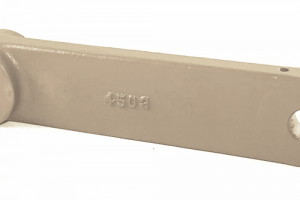The paper cutter knife in your machine is the most important piece of your cutter that you need to maintain. The length of time between sharpenings is critical to nice clean cuts along with the accuracy of the cut. A dull knife will cause draw in the cut from top to bottom. I’m sure you have wondered why the sheets are longer at the top than the area at the bottom. A dull knife could be to blame.
Most new knives are sharpened to a 23-degree bevel, the standard used to 24 degrees, but manufacturers have settled on the 23-degree bevel as the bevel that will work best for most paper stocks. Keep in mind that the bevel is very important, depending on what you are cutting, the bevel may need to be changed for optimum cutting efficiency. In some cases, a knife can have a double bevel, this really helps the cutter’s operation and knife sharpness over time on specific types of paper.
Your knife needs to be sharp all the time. Newer cutters have cycle counters so you have a better idea about when to change the knife. Most knife alarm setpoints are set to 3000 cycles for just regular cutting of cover and text weights stocks. We do set some to 5000 cycles, but that is really pushing it, and the knife will be very dull when changed. The effects of a dull knife are not only in the quality of your paper cutting, but it also puts an additional load on the mechanical parts of the cutter. The knife links generally take the biggest hit; next would be the knife cylinder. These parts will be forced to strain through a cycle. In extreme cases, the knife links will break, or your knife cylinder will experience oil leaking for the top seal as the cylinder rod has to pull the knife through the paper lift with a dull knife.
The type of knife you use in your cutter will make a difference as to how long you can go between sharpenings. I am not a big fan of High-Speed knives on smaller cutters, basically 30” and smaller. High-speed knives are touted as giving you twice the life between sharpening over a regular carbon steel knife; in my experience, I am hard press to agree with that. Most cutters up to 30” will do well with Regular Carbon Steel. High-speed steel knives on smaller cutters do not work as well due to their hardness. These knives are tempered, so they are maybe twice as hard as a Carbon Steel knife; this makes them more likely to chip on the edge. I do think that High-Speed steel knives work well on larger cutters, but larger cutters have more cutting volume than smaller cutters, and it generally takes more time to change a knife on a larger cutter, so a high-speed knife would be worth the additional cost, generally 2 times a much as a regular carbon steel knife.
When you are cutting, be aware that Chipboard will dull your knife very quickly. Generally, if you need to cut chipboard, do it at the end of your knife cycle or when it’s ready to be changed out. We carry high-quality knives from Alliance Knife Company. Alliance Knife is a US-based company that has been making knives for many years. Alliance Knife has been the manufacturer of knives for Challenge Machinery for years. So if you need a new knife, call us, and we can help you.

